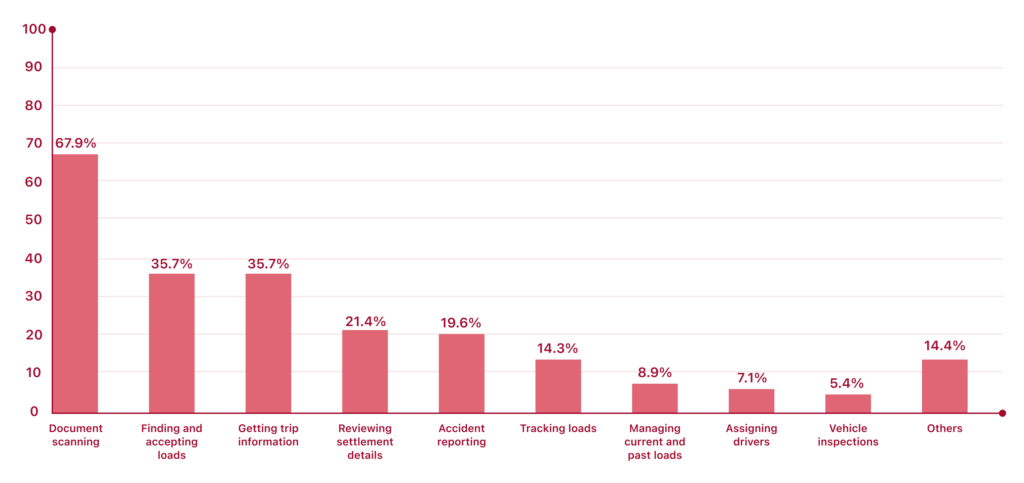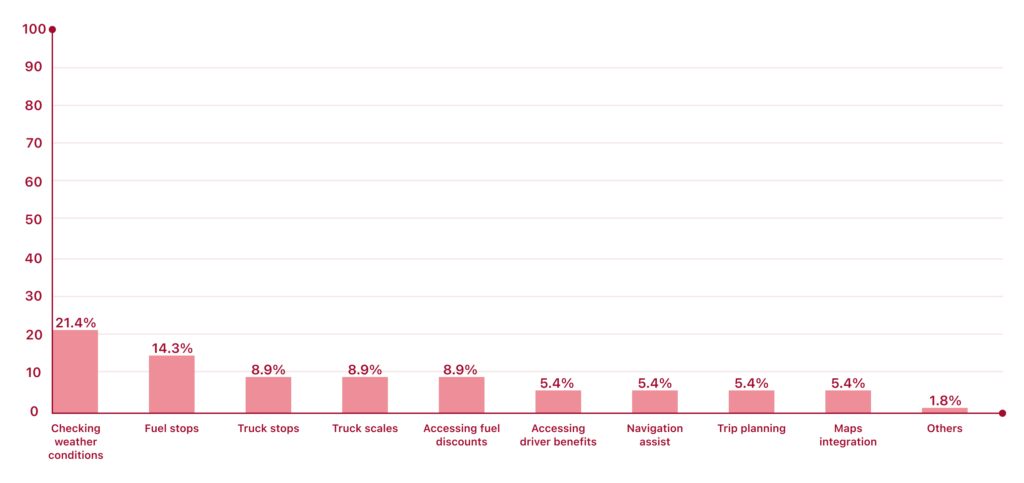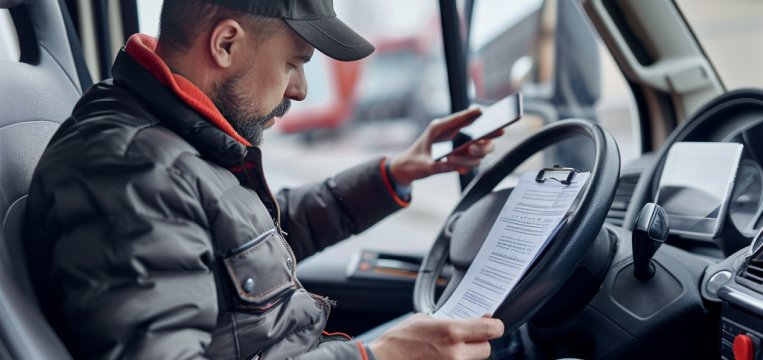In this analysis, we examine the prevalence of trucking apps in the industry and explore their specific functionalities. Our aim is to provide valuable insights for developers and industry stakeholders by highlighting the essential productivity and convenience features of trucking apps.
To this end, we investigated the applications offered by the top 100 North American trucking companies.
The analysis is structured as follows: First, we present our methodology. Second, we examine the number of trucking apps made available by the top 100 trucking companies in North America, what platforms they use, and which use cases they cover. Third, we take a closer look at what features these mobile apps offer drivers and other user groups.
In addition to this, we discuss the advantages and disadvantages of building your own trucking app versus using a white-label solution.
How we conducted our analysis
For our investigation, we analyzed the top 100 North American trucking companies according to the 2024 ranking by the American Journal of Transportation (AJOT). AJOT’s criteria include revenue, number of units, type of business, and ownership model. The list includes companies specializing in third-party, intermodal, truckload, less-than-truckload, expedited, and integrated logistics.
Our research consisted of two steps:
First, we investigated how many of the top 100 trucking companies offer publicly available mobile apps, meaning they can be downloaded from Google Play or the App Store. We also collected data on the operating systems supported by an app, the development framework used, and whether it was a white-label solution.
We then looked at the specific features these mobile apps offer and how they are distributed across all apps. Based on this, we identified several must-have features as well as a number of nice-to-have functionalities.
Let’s start by examining how many of the top 100 trucking companies offer drivers a mobile app.
Prevalence of mobile apps among trucking companies
Out of the 100 companies in AJOT’s ranking, 51 offered at least one mobile app for truck drivers or independent contractors publicly on Google Play or the App Store, making for a total of 56 apps.
Let’s look at their distribution across operating systems and development frameworks, as well as whether they are in-house or white-label solutions.
Platform availability
83.9% of the mobile apps are available for Android, 75% for iOS, and 60.7% on both platforms.
The native development approach is by far the most popular choice among the top 100 companies (55.4%). In terms of cross-platform development frameworks, Xamarin is the most common choice (16.1%), followed by Cordova (12.5%). React Native is less popular (1.7%). The remainder is split among a variety of development frameworks.
We identified 28% as white-label solutions, meaning that companies used a mobile app pre-configured by a software provider. We’ll discuss the pros and cons of this approach later on.
Use cases and target users
Trucking apps serve the needs of many different user groups. Looking at the 56 mobile apps of the top 100 trucking companies, we were able to identify the following use cases:
-
- Internal driver apps (used by the trucking company’s employees): 58.9%
-
- Apps for independent contractors (to find and book loads through a load board): 12.5%
-
- Apps aimed at both internal drivers and independent contractors: 10.7%
-
- Last-mile delivery apps: 8.9%
-
- Fleet management apps (aimed at fleet managers and individual truck drivers): 1.8%
These results suggest that trucking apps are primarily geared towards supporting drivers on the road. Software focused solely on finding loads or other specific use cases (e.g., last-mile delivery) is less common.
Valuable features in trucking apps
We now know which types of trucking apps are most prevalent. But what about their features?
Certain functionalities are widely implemented in trucking apps, representing must-haves for making drivers’ lives easier. Most only appear in a small number of apps.
Let’s take a closer look at the numbers.
Feature distribution in the AJOT top 100’s trucking apps
Driver operations
Load management:
-
- Document scanning: 67.9%
-
- Finding and accepting loads: 35.7%
-
- Getting trip information: 35.7%
-
- Tracking loads: 14.3%
-
- Managing current and past loads: 8.9%
-
- Recommending loads: 3.6%
-
- Saving favorite loads: 3.6%
-
- Accessing important documents: 3.6%
Fleet management:
-
- Assigning drivers: 7.1%
Reporting features:
-
- Accident reporting: 19.6%
-
- Vehicle inspections: 5.4%
Settlements:
-
- Reviewing settlement details: 21.4%
-
- Managing pre-payments: 3.6%

On-route convenience features
Navigation:
-
- Navigation assist: 5.4%
-
- Trip planning: 5.4%
-
- Maps integration: 5.4%
Location finder:
-
- Fuel stops: 14.3%
-
- Truck stops: 8.9%
-
- Truck scales: 8.9%
-
- Inspection sites: 1.8%
Other convenience features:
-
- Checking weather conditions: 21.4%
-
- Accessing fuel discounts: 8.9%
-
- Accessing driver benefits: 5.4%

Communication and internal resources
-
- Messaging: 35.7%
-
- Accessing company news: 19.6%
-
- Accessing driver trainings: 16.1%
-
- Accessing company contacts: 10.7%
-
- Accessing internal resources: 8.9%
-
- Referring drivers: 8.9%
-
- Accessing performance details: 7.1%
-
- Finding career opportunities: 1.8%
-
- Submitting requests for time off: 1.8%

Discussion
These numbers clearly show which features are essential to a good trucking app. Let’s next examine each category more closely.
Driver operations
Trucking apps primarily serve driver operations, specifically load management.
Document scanning is by far the most prominent feature, and for a good reason: Transportation involves a lot of paperwork. The ability to scan and upload documents on the go is an immense time-saver. Therefore, a high-quality document scanner component is a must for trucking apps.
Functions for finding, accepting, managing, and tracking loads are also common for trucking apps. With load management features, drivers can quickly find suitable loads via load boards and access further information about them, including the required stops, drop-off times, and more. Some apps are able to recommend loads based on driver-defined criteria.
Furthermore, many apps allow drivers to report accidents and review settlement details. While the former feature facilitates prompt resolution of incidents and regulatory compliance, the latter fosters transparency between drivers and companies.
On-route convenience features
Many trucking app features do not concern driver operations directly, but are conveniences that help drivers work more effectively.
Features for easy access to weather information are common, as are those helping drivers find points of interest such as fuel stops, truck scales, and inspection sites. Some apps also enable drivers to access fuel discounts and other benefits.
Counterintuitively, only a few trucking apps offer navigational assistance. We hypothesize that drivers usually switch to another app or device for trip planning and navigation, for instance their vehicles’ built-in GPS. This eliminates the need for these features in the trucking app.
Communications and miscellaneous trucking app features
Many trucking apps offer additional functionalities that fall outside the previously mentioned categories. Among those, a messaging feature is the most common. This enables drivers to receive messages within the trucking app and communicate with other stakeholders.
Several trucking apps give access to internal resources such as training material, company contacts, and links to important information. Some also provide drivers with an overview of their own performance over a given period of time.Finally, some trucking apps let drivers refer other drivers. This is an underrated feature that more trucking apps may want to adopt – after all, drivers are in high demand. Recommendations from the drivers themselves are a valuable resource for recruiting and thus help strengthen a company’s workforce.
Summary
A successful trucking app must cater to drivers’ needs, streamline operations, and enhance overall efficiency.
The crucial component – present in nearly 70% of the apps – is document scanning, which facilitates paperwork handling on the go. Other major components are related to load management, accident reporting, and access to settlement details. All these contribute significantly to operational smoothness and compliance.
While on-route convenience features such as weather updates and point-of-interest locators aid drivers directly, miscellaneous functionalities like messaging, resource access, and referral programs add value by fostering communication, providing support, and leveraging driver networks. Conversely, navigational assistance is rarely included, as other solutions typically cover the need.
The road to your own trucking app: Should you build or buy?
If your transportation company wants to provide its drivers with a trucking app, a crucial decision is whether to build your app yourself or pay to use a white-label solution.
Both approaches have their pros and cons, which we’ll discuss here.
Buy: Trucking app as a service
Relying on a white-label solution has several advantages.
First, there is no need for a dedicated software development team. You will still need people capable of applying updates from your provider to your trucking app, but this pales compared to the workforce required to develop a mobile or web application – and continuously maintain it.
Second, pre-built software often already includes many frequently requested functionalities. This saves you the trouble of creating a complete specification covering all your use cases. You and your drivers might even grow to appreciate some of the built-in features you didn’t think you needed.
Finally, there’s no faster way to get your trucking app on the road than buying a white-label solution. Configuring the pre-built modules and UI can take as little as a few working days. This means you can quickly start distributing your trucking app to your drivers.
Still, white-label software also has drawbacks.
For one, customization options are often minimal. If you have a very specific use case, a pre-built solution might not cover the required feature set.
For another, while the cost of software as a service is generally lower than that of in-house development, this may change as your company grows. As some providers base their fees on your usage volume or the number of devices, the cost burden scales with your success. In the long run, developing your own trucking app can be more cost-effective.
Lastly, depending on a third-party provider for such a vital tool can be risky. As a customer, you have limited influence on development, and the vendor’s business decisions might suddenly leave you looking for an alternative. Creating your own app can thus be the safer choice.
Build: Assembling your own trucking app
Compared to using an off-the-shelf solution, building your own trucking app involves a higher initial investment, but also gives you complete control over the software.
With an in-house solution, your developers can tailor your app’s feature set precisely to your needs. This ensures that you only pay for functionalities that actually benefit your driver operations. Your development team can also quickly react to regulatory framework changes, business strategy shifts, and driver feedback.
Developing your app in-house also ensures compatibility with your existing systems, which can be a problem with pre-configured software. Transmitting specific data from your database to your trucking app and vice versa may be impossible with the APIs your white-label solution ships with. By building the app yourself, you have complete control over how your trucking app communicates with the rest of your software.
A key advantage of not relying on a third party for your trucking app is that you can avoid recurring fees and hidden costs. High-quality white-label solutions do offer a wide range of features – but you often have to pay for all of them, whether you use them or not. Every new feature built by your development team, conversely, is a targeted investment.
Building a trucking app in-house doesn’t mean your developers have to write the entire code from scratch. Thanks to SDKs (software development kits), you can integrate complex features into your app without having to develop them yourself. An SDK comes with all the tools, APIs, and UI components your team needs for a smooth implementation.
Conclusion
By establishing the prevalence of mobile apps among the top 100 trucking companies, uncovering key functionalities, and identifying dominant use cases, we have identified the essential features that define successful trucking applications.
The most common by far is document scanning, followed by load management, messaging, and on-the-road convenience features such as truck stop finders. Each of these components can significantly enhance driver efficiency and satisfaction.
We have also examined whether it is better to build your own trucking app or buy a white-label solution.
The answer depends on your needs, resources, and long-term goals. On the one hand, buying a white-label solution offers immediate access to a functional trucking app, minimizing the lead time and the need for dedicated developers. On the other hand, building your own app gives you complete control over features and integration with existing systems, and can also be more cost-effective in the long run.
Which features are vital for such an app, and whether to build or buy a solution, ultimately depends on your company’s unique circumstances and objectives. One thing is clear, however: A good trucking app elevates your operational efficiency and driver satisfaction, both crucial for sustained success in transportation and logistics.
